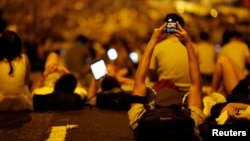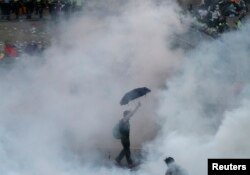A torrent of tweets and Facebook posts is pouring out of Hong Kong documenting the “Umbrella revolution,” but social media does not appear to be driving the protesters as it did the Arab Spring, also called the Facebook revolution.
“I don’t think social media is playing a huge role in Hong Kong” said Adam Segal a China expert at the Council on Foreign Relations, a nonpartisan think tank. “Clearly, it allows [protesters] to capture images and spread them quickly, but it’s not as if the protests were not going to be covered [by the media].”
Segal said that in Hong Kong there was already a strong political infrastructure that was mobilizing people and spreading the message.
“It was not like Arab Spring,” he said, during which social media fueled protests in the Middle East by helping “convince people they were not alone.”
Social media's role
Doug Young, a journalism professor at Fudan University in Shanghai and author of the book The Party Line: How the Media Dictates Public Opinion in Modern China, agrees that social media has not been a factor in spurring the protests.
“The thing about Hong Kong is it’s an open society,” he said. “It’s not like China or many Muslim countries where everything it tightly controlled. People can organize the way they want and don’t have to be stealthy.”
But social media does offer a unique chance to view the protests and to document developments. According to data collected by Twitter, there were 1.3 million tweets about the demonstrations from Sept. 26 through Sept. 30.
Social media also documented the harsh crackdown on protesters by the Hong Kong police, images the likes of which largely did not emerge from the 1989 protests at Tiananmen Square. In Hong Kong, photos showing the use of riot gear, pepper spray, tear gas and police batons, as well as the detention of peaceful protesters were common.
Like Tiananmen, the Hong Kong protests may become symbolized by one powerful photo: a man holding an umbrella who is enveloped in a cloud of tear gas who is now being called “umbrella man.”
Some are comparing the image to the iconic “tank man” image from Tiananmen Square. That image depicted a solitary man challenging a tank, blocking its way and apparently pleading for it to stop.
While China would like to erase any memory of Tiananmen Square it is clear the dramatic events from 25 years ago are not forgotten. One popular meme making the social media rounds superimposes umbrella man were tank man stood.
A user of Sina Weibo, also called Chinese Twitter, posted "Ti*n*men Echoes: H*ng K*ng."
Tiananmen demonstrated it wasn’t necessary to have Twitter or Facebook to bring out a large crowd. On May 19, the day the Chinese government declared martial law, over a million people flooded the square, showing that word of mouth and fax machines could be used to great effect in rallying people to action.
2003 protests
In 2003, well before social media was widely used, hundreds of thousands took the streets of Hong Kong to protest the proposal of Article 23 of the Hong Kong Basic Law. Protesters said the law curtailed civil rights, and the article was shelved.
News and social media coverage of the Hong Kong protests are unlikely to go dark, as happened at Tiananmen when Beijing blocked Western media broadcasts and forbade reporters from taking pictures or videos.
Many Hong Kongers are using a mobile phone app called FireChat, which does not require a network connection to send messages, because it uses bluetooth technology.
So far the numbers of protesters in Hong Kong has been reported in the tens of thousands, but Segal thinks that number could approach a million over the National Day holiday.
Most worrying to Beijing is that calls for greater democracy in Hong Kong will spread to the mainland via social media. For now, however, the mainland media presents events in Hong Kong as illegal and a threat to stability.
“It’s an imageless story,” said Young. “Certainly [there are] not any sort of inflammatory photos.”
And it’s being tightly controlled online as well.
'Great Firewall'
China’s efficient "Great Firewall,” which allows the government to effectively censor the Internet has, for the most part, kept images and news from Hong Kong off the mainland’s Internet. Popular platforms like Facebook and Twitter are blocked, and China has blocked access to the popular photo sharing application Instagram.
But the longer the protests go on, the more likely images and news from Hong Kong will seep into China, said Segal.
Some already have.
"Facing a strong opponent, we can only use umbrellas!" said a user on Sina Weibo.
Another said: "Let BJ see the light #umbrella revolution#", in an apparent reference to Beijing.
Young said he’s seen oblique references to events on Hong Kong which utilized shorthand to avoid the censors.
On Sina Weibo and Tencent Weibo, another social platform, search results for "Occupy Central", a catch-all phrase for the Hong Kong protests, showed a page that said "according to relevant laws, regulations and policies, search results are not displayed".
“Clearly the Chinese government is worried about it,” said Segal. “I’m sure they’ll have to censor ‘umbrella’ if they already haven’t.”
Here are some photos of the protests posted on Twitter:









